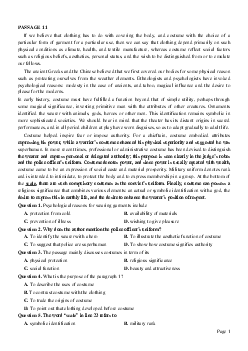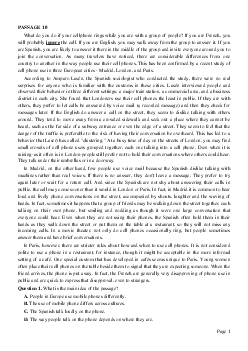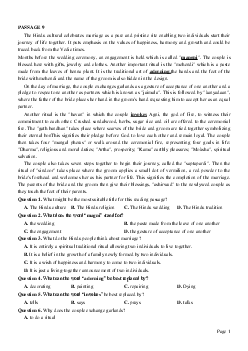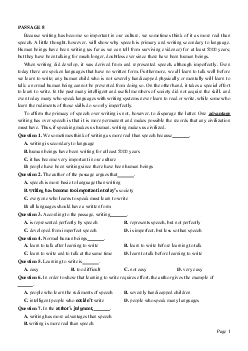


Preview text:
PASSAGE 27
Increasing numbers of parents in the U.S. are choosing to teach their children at home. In fact the U.S.
Department of Education has estimated that in 1999, about 850,000 children were being homeschooled.
Some educational experts say that the real number is double this estimate and the ranks of homeschooled
children seem to be growing at the average rate of about eleven percent every year.
At one time, there was a theory accounting for homeschooling: it was traditionally used for students
who could not attend school because of behavioral or learning difficulties. Today, however, more parents
are taking on the responsibility of educating their own children at home due to their dissatisfaction with
the educational system. Many parents are unhappy about class size, as well as problems inside the
classroom. Teacher shortages and lack of funding mean that, in many schools, one teacher is responsible
for thirty or forty students. The children are, therefore, deprived of the attention they need. Escalating
classroom violence has also motivated some parents to remove their children from school.
Although there have been a lot of arguments for and against it, homeschooling in the U.S. has become
a multi-million dollar industry and it is growing bigger and bigger. There are now plenty of websites,
support groups and conventions that help parents protect their rights and enable them to learn more about
educating their children. Though once it was the only choice for trouble children homeschooling today is
an accepted alternative to an educational system that many believe is failing.
Question 1. The number of parents who want to teach their own children in the U.S. is A. remaining unchanged B. remaining the same C. going up D. going down
Question 2. This estimated number was presented by
A. a governmental office B. school teachers C. the parents
D. homeschooled children
Question 3. According to some experts, the exact number of homeschooled children then must be A. 1,600,000 B. 850,000 C. 1,900,000 D. 1,700,000
Question 4. The attitude of the author towards homeschooling can be best described as A. acceptable B. favorable C. remarkable D. unfavorable
Question 5. More parents teach their children because they completely the current educational system A. please with B. object to C. appeal to D. approve of
Question 6. Many parents stop their children from going to school because it is now too for them. A. explosive B. expensive C. dangerous D. humorous
Question 7. Parents can teach children at home with the support of
A. the internet, conventions along with support groups
B. support groups, teachers and websites
C. documents, websites and support groups
D. books, support groups and the Internet
Question 8. Which is the best title for the passage? Page 1
A. Reasons for Homeschooling in the USA.
B. The Trend of Homeschooling in the USA.
C. Homeschooling-One of the Ways of Education in the USA.
D. Education System in the USA. ĐÁP ÁN 1-C 2-A 3-D 4-B 5-B 6-C 7-A 8-C
LỜI GIẢI CHI TIẾT Question 1: C
Số lượng phụ huynh muốn dạy con cái của họ ở Hoa Kỳ là A. không đổi B. còn lại như cũ C. tăng lên D. đi xuống
DẪN CHỨNG: Increasing numbers of parents in the U.S. are choosing to teach their children at home.
DỊCH: Ngày càng nhiều phụ huynh ở Hoa Kỳ đang chọn dạy con tại nhà. Question 2: A
Con số ước tính này đã được trình bày bởi
A. một văn phòng chính phủ B. giáo viên C. cha mẹ D. trẻ học tại nhà
DẪN CHỨNG: In fact the U.S. Department of Education has estimated that in 1999, about 850,000
children were being homeschooled.
DỊCH: Trên thực tế, Bộ Giáo dục Hoa Kỳ đã ước tính rằng vào năm 1999, khoảng 850.000 trẻ em đang được học tại nhà. Question 3: D
Theo một số chuyên gia, số lượng chính xác của trẻ học tại nhà sau đó phải là A. 1.600.000 B. 850.000 C. 1.900.000 D. 1.700.000
DẪN CHỨNG: Some educational experts say that the real number is double this estimate and the ranks
of homeschooled children seem to be growing at the average rate of about eleven percent every year.
DỊCH: Một số chuyên gia giáo dục nói rằng con số thực là gấp đôi ước tính này và hàng ngũ trẻ em học
tại nhà dường như đang tăng với tốc độ trung bình khoảng mười một phần trăm mỗi năm. Question 4: B
Thái độ của tác giả đối với homeschooling có thể được mô tả tốt nhất là A. chấp nhận được B. thuận lợi C. đáng chú ý D. không thuận lợi Question 5: B
Nhiều phụ huynh dạy con vì họ hoàn toàn
hệ thống giáo dục hiện tại A. làm ơn với B. phản đối C. kháng cáo D. tán thành
DẪN CHỨNG: Today, however, more parents are taking on the responsibility of educating their own
children at home due to their dissatisfaction with the educational system. Many parents are unhappy about Page 2
class size, as well as problems inside the classroom. Teacher shortages and lack of funding mean that, in
many schools, one teacher is responsible for thirty or forty students. The children are, therefore, deprived
of the attention they need. Escalating classroom violence has also motivated some parents to remove their children from school.
DỊCH: Tuy nhiên, ngày nay, nhiều phụ huynh đang đảm nhận trách nhiệm giáo dục con cái tại nhà do
không hài lòng với hệ thống giáo dục. Nhiều phụ huynh không hài lòng về quy mô lớp học, cũng như các
vấn đề bên trong lớp học. Thiếu giáo viên và thiếu kinh phí có nghĩa là, ở nhiều trường, một giáo viên
chịu trách nhiệm cho ba mươi hoặc bốn mươi học sinh. Những đứa trẻ, do đó, không được chú ý. Bạo lực
trong lớp học cũng đã thúc đẩy một số phụ huynh đưa con ra khỏi trường. Question 6: C
Nhiều bậc cha mẹ ngăn con cái họ đi học bởi vì bây giờ nó quá cho họ. A. nổ B. đắt C. nguy hiểm D. hài hước
DẪN CHỨNG: Escalating classroom violence has also motivated some parents to remove their children from school.
DỊCH: Bạo lực trong lớp học cũng đã thúc đẩy một số phụ huynh đưa con ra khỏi trường. Question 7: A
Cha mẹ có thể dạy con tại nhà với sự hỗ trợ của
A. internet, các công ước cùng với các nhóm hỗ trợ
B. nhóm hỗ trợ, giáo viên và trang web
C. tài liệu, trang web và các nhóm hỗ trợ
D. sách, nhóm hỗ trợ và Internet
DẪN CHỨNG: There are now plenty of websites, support groups and conventions that help parents
protect their rights and enable them to learn more about educating their children.
DỊCH: Hiện tại có rất nhiều trang web, các nhóm hỗ trợ và quy ước giúp phụ huynh bảo vệ quyền của họ
và cho phép họ tìm hiểu thêm về việc giáo dục con cái. Question 8: C
Đó là tiêu đề tốt nhất cho đoạn văn?
A. Lý do cho việc học tại nhà ở Hoa Kỳ.
B. Xu hướng học tại nhà ở Hoa Kỳ.
C. Giáo dục tại nhà - Một trong những cách giáo dục ở Hoa Kỳ.
D. Hệ thống giáo dục tại Hoa Kỳ. Page 3




